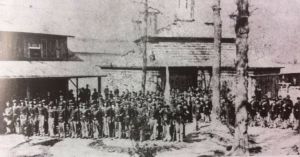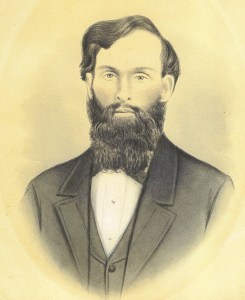James C. Fullenwider was born on the family farm in Brown Township, between the towns of Waveland and Browns Valley, 1838. His parents, Eleazer and Lavinia Allen Fullenwider had migrated to Montgomery County from Kentucky. James was the 9th child of eleven. When war swept over the country, the Fullenwider sons answered the call. James would have two brothers in the 40th Indiana Infantry, two brothers in the 55th Indiana Infantry, and one brother in the 78th Indiana Infantry.
On September 19, 1861, James enlisted in Company E, 33rd Indiana Volunteer Infantry Regiment. His company was primarily made up of men from Parke County, Indiana. The 33rd Indiana saw early action at Camp Wildcat, Ky., and later helped to occupy Cumberland Gap. By early 1863 James and the 33rd were near Franklin, Tennessee, members of Col. John Colburn’s Brigade (Colburn was a Wabash College grad). This was during a period after the battle of Stones River, Confederate cavalrymen under Earl Van Dorn were very active in the Columbia and Franklin Tennessee area.
On the morning of March 24, 1863, Coburn’s Brigade was sent out of Franklin, south on the Columbia Turnpike to probe Confederate cavalry forces actively engaged in interrupting Union supply lines. Coburn started out with his brigade, some cavalry and a small wagon train. Gen. Van Dorn, watching the Union column, decided to try and draw Coburn away from reinforcements in Franklin and isolate it. Van Dorn would send small squads out to temporarily engage the Union brigade, then retreat, and engage once more. Basically a hit and run tactic. The hope was that Colburn would pursue the small Confederate force with his larger brigade. The trap was laid and Colburn took the bate. It came to a climax four miles outside of Franklin, in a small valley near Thompson’s Station. The enemy cavalry now started applying more pressure on the Union brigade., As Colburn started to fan out his brigades battle lines, the Confederates began to apply more pressure against him. Colburn pushed ahead to a small hilltop, knowing that high ground was a better position to be in and also hoping the trees would help protect his brigade flanks. At one point he 33rd and 85th Indiana tried to advance, but had to turn back. Now the Confederates started applying their numbers. A Confederate cavalry brigade under William Hicks “Red” Jackson was dismounted; making bold frontal assaults. Another force under Nathan Bedford Forrest, started chipping away at Colburn by attacking the flank and rear of his Union brigade. James and the 33rd, as well as the 85th Indiana were fighting for dear life on the right side of the Columbia Turnpike. The Confederates were pushing in and closing the distance to the Colburn’s battle line. Eventually the pressure and numbers became to much, Colburn’s lines started to waver and collapse. Colburn was eventually left with no other choice, but to surrender his command. 
The 33rd Indiana Infantry in the field near Franklin., 1863. This image was taken before the battle of Thompson’s Station.
James Fullenwider and the 33rd Indiana fought well that day, but their commander had been drawn in to a trap. It became apparent to the men that they were outnumbered and outmaneuvered. Sometime during this action, James C. Fullenwider was killed in this action. The grave of James cannot be located in any of the National Cemetery’s databases, It is not really known what happened to his remains. There is a tombstone that contains his name and death date at the Waveland Presbyterian Cemetery, Waveland, Ind. Robert “Bob” Fullenwider stated that “the remains of James are not there, his name was placed on the family stone in memory of him. ” This is the sad and terrible price of war, and it was to be repeated many times across Montgomery County.
